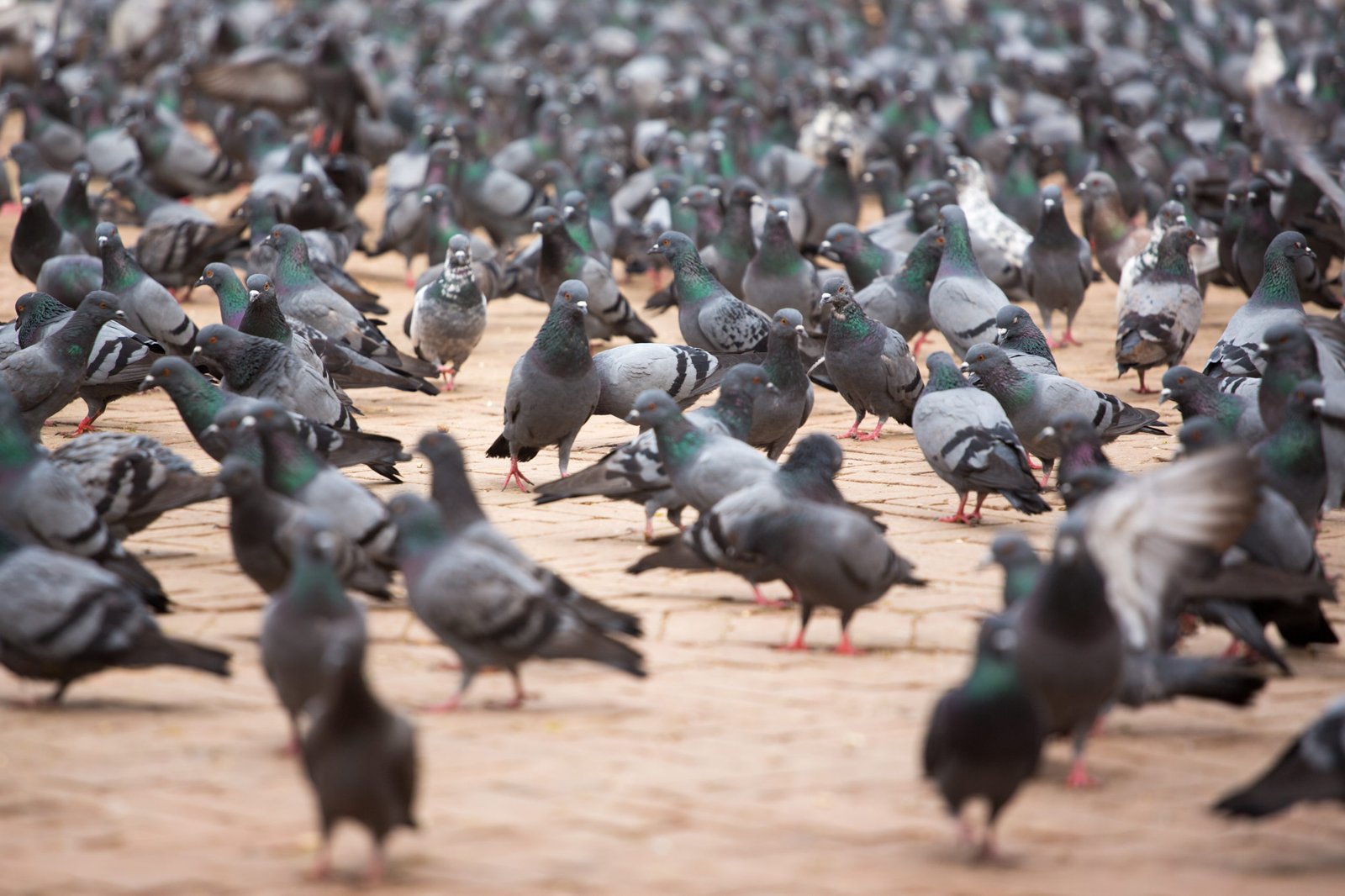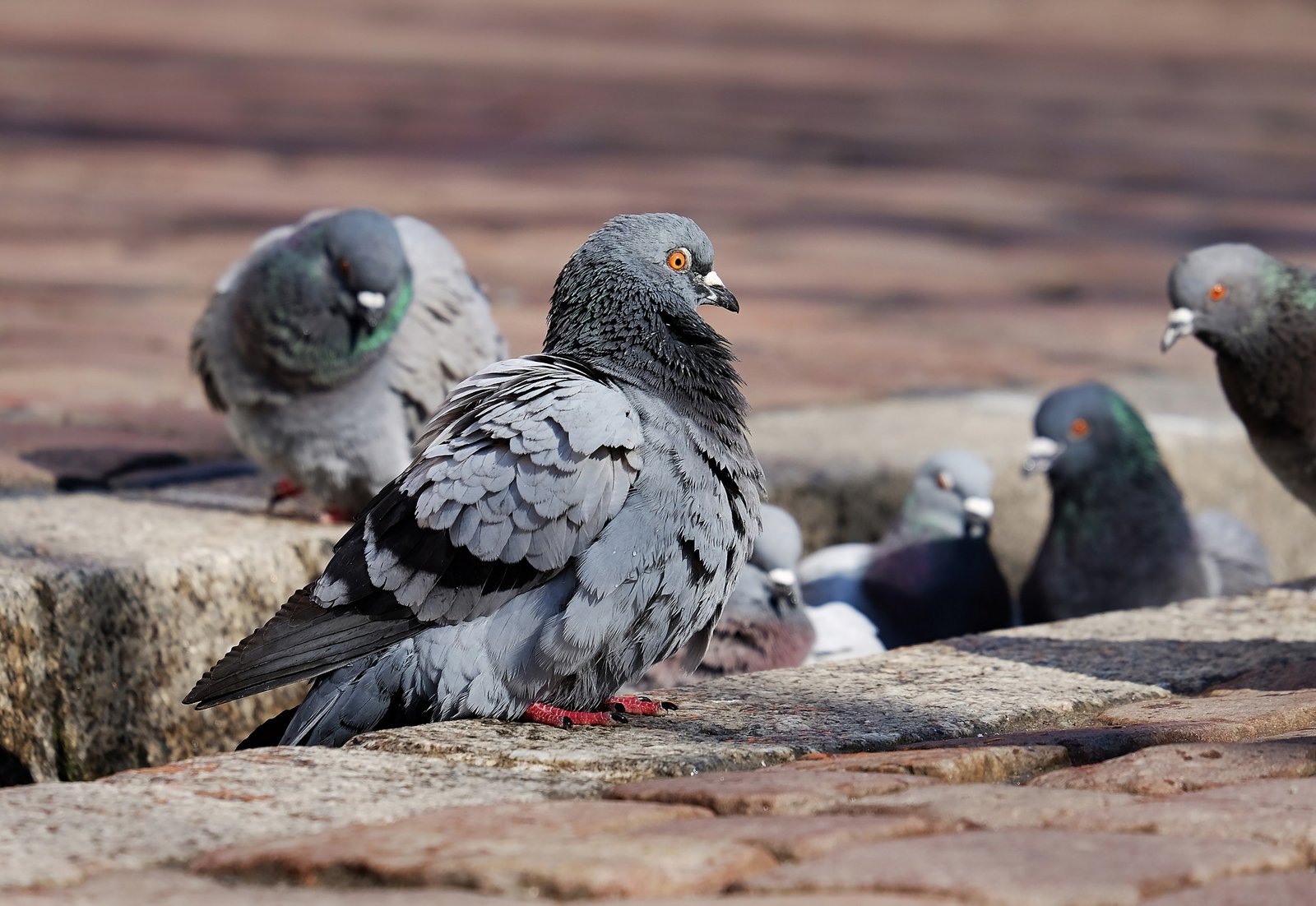Pigeon: Columba Livia

Description Of The Pigeon
Pigeons are small, tubby birds with short legs and small heads. Their tail is wide and rounded, and their wings are broad but pointed. Color varies, but most birds are bluish-gray with two black bands on the wings and a black tail tip. The throat feathers of most birds are iridescent. Two bars, dark spots, or plain wing patterns are all possible. The tip of a pigeon’s tail is usually dark.
Learn More: Destructive Bird Species
Pigeon Habitats
Natural habitats for these birds include cliffs, particularly sea cliffs. Introduced and feral individuals can live on cliffs, but they have found a perfect home in the city.
Because humans produce a lot of garbage, cities provide them with ideal scavenging opportunities. Humans not only produce a lot of garbage, but they produce even more in densely populated urban and city areas.
Range & Distribution Of Pigeons
These birds can be found in southern Europe, western Asia, and northern Africa in their natural habitat. They can be found in both the western and southern parts of Europe and the western and southern parts of Asia.
They’ve also been introduced to a lot of different places. The rest of Europe, other parts of Asia, southeast Australia, southern Africa, parts of South America, parts of Canada, and the entire United States and Mexico make up their non-native range.
Pigeon Behavior
Pigeons run and walk with their heads bobbing forward and backward. They fly in a straight and steady path. Pigeons are most visible during daylight hours, seeking shelter at night and inside during the day, depending on the climate. They congregate while roosting, sunning, and feeding, but there has been no evidence of play. Both sexes are aggressive in the nesting territory, pecking intruders on the head. 1Go To Source animaldiversity.org -“Columba livia common pigeon (Also: rock dove)”
Reproduction Cycle Of Pigeons

Pigeons are monogamous birds and stay with the same mate for life, but they may choose a new one if one mate dies. Although breeding may occur at any time of year, the spring and fall seasons are the most productive. Male pigeons strut and are more aggressive. Males fluff up their neck ruffs, drag their tails on the ground, and make loud, cooing noises in a mating display. While the male chooses the nesting site, both sexes help build the nest.
Twigs and grasses make up the nests, which are often found on building ledges and rafters, as well as in eaves, steeples, and vents. Both male and female pigeons defend the nest site aggressively and share in the eggs’ incubation.
Clutch size ranges from one to two, with an incubation period of 17 to 19 days. Pigeon milk produced inside the crop of both parents is fed to newly hatched pigeons or squabs. The young pigeons leave the nest at four to six weeks of age. Before the first young can fly, more eggs may be laid. 2Go To Source portal.ct.gov -“Rock Pigeon Columba livia”
Pigeon Diet
Pigeons, which predominate in our cities and urban environments, will eat almost anything, including insects and leftover food. Wild pigeons will eat anything that comes their way. Insects like worms and ants and seeds, fruits, berries, and vegetables fall into this category.
Pigeons have successfully adapted to our urban environments, allowing them to nest, feed, and thrive in even the busiest cities. They aren’t as fortunate as wild pigeons when it comes to their diet and living conditions. Urban pigeons eat whatever they can get their hands on, and their diet includes almost anything, including food that we throw away or drop.
Wild pigeons, unlike urban pigeons, have access to a much healthier diet. Because wild pigeons typically live in forests and coastal areas, their diet depends entirely on what nature provides.
Diseases Carried By Pigeons
Pigeon droppings and feathers are left at roosting sites when population density reaches a certain level. These piles can harbor a variety of diseases, and if bird pest control measures aren’t taken, they can cause serious problems. Common diseases carried by pigeons include Histoplasmosis, Psittacosis, and Cryptococcosis.
- Histoplasmosis– Infection is caused by inhaling fungus spores commonly found in bird and bat droppings. When these spores are inhaled after being exposed to the air, such as during demolition or cleanup projects, the infection is most commonly spread. 3Go To Source mayoclinic.org -“Histoplasmosis”
- Psittacosis-Humans are infected with a virus that causes mild, non-specific flu-like symptoms. Chlamydia psittaci, one of several microorganisms in the Chlamydia genus, causes psittacosis, infection, or disease. Humans can contract this disease from infected birds. 4Go To Source ccohs.ca -“Psittacosis”
- Cryptococcosis– A fungus that can be found in the environment all over the world. Most people will inhale this microscopic fungus at some point in their lives but will never become ill as a result of it. On the other hand, Cryptococcus can remain hidden in the body in people with weakened immune systems, such as people with HIV, and later cause a serious brain infection known as cryptococcal meningitis. 5Go To Source cdc.gov -“Preventing Deaths from Cryptococcal Meningitis”
Pigeons As Pests
Pigeons are filthy birds that spread disease and cause property damage. Human slips and falls have been linked to their droppings, as well as the accelerated aging of structures and statues. Pigeons must be removed from high-traffic areas as a result of this. Pigeons can carry diseases like cryptococcosis, toxoplasmosis, salmonella, food poisoning, and other illnesses. Also, the fungus that causes histoplasmosis may grow in their droppings. Other pests, such as fleas, lice, mites, ticks, and other parasites, may live on these birds.
Damage Caused By Pigeons

Bird droppings are widely regarded as the most serious symptom of a bird infestation. Pigeon droppings, in particular, can carry more than 60 diseases and parasitic organisms that are dangerous to humans. Microorganisms found in dried pigeon droppings can cause a variety of diseases when inhaled. Droppings can also cause property damage, discoloring building, and car paint, destroying wood, clogging gutters, staining fabric, and shorting out electrical equipment. Pigeon droppings can harm a property’s image or a home’s curb appeal in addition to causing physical damage.
Pigeon Trapping & Removal
The longer pigeons have been on a structure, the more difficult it is to remove them completely. They are initially obstinate, and as time passes, they become even more so. Even the most effective pigeon proofing measures may only move the birds from where they are currently nesting to another location on the structure. If necessary, they will even move their nests out into the open areas of a roof in order to stay there.
A trapping program, combined with exclusion work, makes the most sense in this situation. Bird netting, spike strips, screening, and other measures will keep pigeons out of the areas that initially attracted them to the structure (such as under solar panels or roof-mounted air conditioning units), preventing the emergence of a new problem.
Because pigeons are accustomed to human interaction, certain methods, such as scare tactics, are usually ineffective in removing them. Federal or state laws do not protect pigeons because they are feral birds; however, local ordinances may exist; it is still best to contact Animals Happen to deal with the wild animals. Our wildlife experts know how to remove pigeons in a humane manner, allowing populations to return to normal.
Sources:
- Roof, J. 2001. “Columba livia” (On-line), Animal Diversity Web. Accessed March 09, 2021 at https://animaldiversity.org/accounts/Columba_livia/
- “Rock Pigeon.” CT.Gov – Connecticut’s Official State Website, State Of Connecticut, portal.ct.gov/DEEP/Wildlife/Fact-Sheets/Rock-Pigeon#:%7E:text=Food%3A%20Primarily%20grain%20and%20seed,in%20livestock%20manure%2C%20and%20insects. Accessed 9 Mar. 2021.
- Mayo Clinic Staff. “Histoplasmosis – Symptoms and Causes.” Mayo Clinic, Mayo Clinic, 20 Feb. 2020, www.mayoclinic.org/diseases-conditions/histoplasmosis/symptoms-causes/syc-20373495.
- “Psittacosis.” Canadian Centre For Occupational Health And Safety, Canadian Centre for Occupational Health & Safety, www.ccohs.ca/oshanswers/diseases/psittacosis.html. Accessed 9 Mar. 2021.
- “Preventing Deaths from Cryptococcal Meningitis | Fungal Diseases | CDC.” CDC, U.S. Department of Health & Human Services, www.cdc.gov/fungal/cdc-and-fungal/cryptococcal-meningitis.html. Accessed 9 Mar. 2021.
